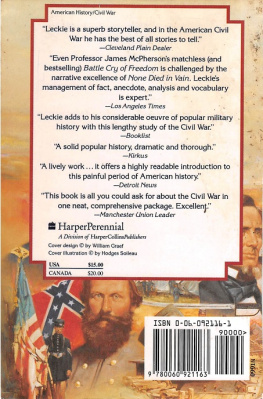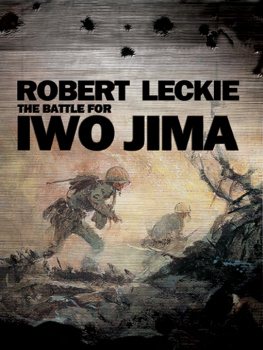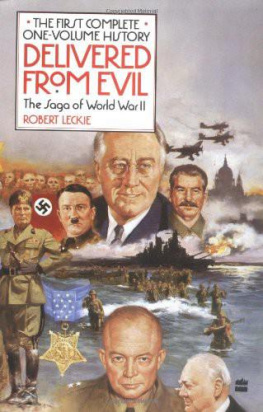Robert Leckie - 25 Sept
Here you can read online Robert Leckie - 25 Sept full text of the book (entire story) in english for free. Download pdf and epub, get meaning, cover and reviews about this ebook. year: 25 Sept 2001, publisher: HarperCollins, genre: History. Description of the work, (preface) as well as reviews are available. Best literature library LitArk.com created for fans of good reading and offers a wide selection of genres:
Romance novel
Science fiction
Adventure
Detective
Science
History
Home and family
Prose
Art
Politics
Computer
Non-fiction
Religion
Business
Children
Humor
Choose a favorite category and find really read worthwhile books. Enjoy immersion in the world of imagination, feel the emotions of the characters or learn something new for yourself, make an fascinating discovery.
- Book:25 Sept
- Author:
- Publisher:HarperCollins
- Genre:
- Year:25 Sept 2001
- Rating:3 / 5
- Favourites:Add to favourites
- Your mark:
- 60
- 1
- 2
- 3
- 4
- 5
25 Sept: summary, description and annotation
We offer to read an annotation, description, summary or preface (depends on what the author of the book "25 Sept" wrote himself). If you haven't found the necessary information about the book — write in the comments, we will try to find it.
25 Sept — read online for free the complete book (whole text) full work
Below is the text of the book, divided by pages. System saving the place of the last page read, allows you to conveniently read the book "25 Sept" online for free, without having to search again every time where you left off. Put a bookmark, and you can go to the page where you finished reading at any time.
Font size:
Interval:
Bookmark:
ON THE MORNING of September 9, 1847, General Winfield Scott realized that he had to attack Mexico City. His position, though not exactly desperate, was at least serious. Here he was on the outskirts of the Mexican capital, his little invading army dwindled down to 7,000 men, at the end of a supply line running 250 miles through hostile territory to Vera Cruz on the Gulf, with no hope of reopening this base until the dread vomito fever vanished in November. Before General Antonio de Lopez Santa Anna became alive to the possibilities of this vulnerable supply linehow he might sever it at will and starve the invading gringos into submissionScott simply had to destroy him.
At a conference that day with his volunteer generals, and his cherished regular army staff officers such as Captain Robert E. Lee, Captain Joe Hooker, and Lieutenant G.P.T. Beauregard, the towering Scottat six feet five inches and 250 pounds easily the most commanding presence in the U.S. Armyexplained that there were two approaches: one to the west and the other to the south. His generals and Lee favored the southern route, but Beauregardthe Little Creole, as he was calledargued cogently for striking the fortress of Chapultepec in the west. This, he said, would unmask two readily traversed causeways into the city. Hearing him, General Franklin Pierce changed his vote to Chapultepec. Scott agreed. Clapping on his head the plumed hat that, with his fastidious nature, had earned him the unwelcome nickname of Old Fuss n Feathers, Scott arose and said: Gentlemen, we shall attack by the western gates.
It was a happy choice. On the morning of September 12, the Americans seized the vacant Molino del Rey and Casa Mata on the western end of the Chapultepec complex. The most furious American bombardment of the Mexican War began battering the castle. Inside General Nicolas Bravo called for reinforcements. But Santa Anna had no desire to send any of his remaining 6,000 soldiers into what might become a slaughter pen. Bravo had to hold the fortress with fewer than 1,000 men, of whom a hundred were young cadets of the Mexican Military College in Chapultepec.
Against them came General Gideon Pillows division issuing out of the Molino and General William Worths division striking the bastions eastern end. Pillows men, rushing whooping through a cypress grove, were scythed by a withering fire, and he was himself wounded. Lieutenant James Longstreet, rushing up with a flag in his hand, went down, and the colors were caught and carried forward by Lieutenant George Pickett. On the left Mexican musketry routed the men around Lieutenant Tom Jackson as he tried to manhandle a gun forward single-handed. Theres no danger! Jackson cried. See, Im not hit! But his gunners remained under cover until a column of regulars appeared. Among them was Lieutenant Ulysses S. Grant, making a mental note that the humorless Jackson also had no fear.
On the east General John Anthony Quitman was taking heavy casualties. The fight was hand-to-hand with crossed swords and clubbed muskets. For a time, the Mexicans held firm, but then gave wayall but the cadets, many of whom fought on to the death and entered Mexican history as Los Ninos, or the Little Ones. Six of them, aged thirteen to nineteen, gave up their lives rather than surrender. Agustin Melgar fought the Americans step-by-step up the stone stairs of the college until he reached the roof, where Yankee bayonets ended his gallant young life. Lieutenant Pickett stepped over his dying body to haul down the green-red-and-white Mexican tricolor and run up the Stars and Stripes. Cheers rose from the rooftop. Chapultepec had fallen.
The battle was now a race for the city. Quitman had the shorter route. His men smashed through the Belen Gate into the capitals outskirts. The Mexicans under Santa Anna fought back savagely from the Citadel and Belen Prison. The Americans hung on against mounting casualties, some of them taking refuge in the network of canals. As night fell, General Quitman fell into a canal, losing his left shoe. In the morning, September 14, 1847, his uniform still damp, his left foot bare, Quitman drew his sword and led his men forward. He expected a bitter battle. But the Citadel was silent. A flag of truce waved from its ramparts. During the night Santa Anna, aware that his outer defenses had been breached, had retired from his position to Guadalupe Hidalgo in the north. Before leaving, he freed some 2,000 convicts to prey upon the detestable gringos.
Quitman quickly occupied the Citadel. But then, hearing that the freed criminals were plundering the city, the half-shod general marched his men into the Grand Plaza. He formed them in the great square in the shadow of the Cathedral and sent a detachment of U.S. Marines under Lieutenant A. S. Nicholson into the National Palace to clear it of brigands.
Atop the Palace itself, the legendary Halls of Montezuma, Nicholson cut down the Mexican flag and flung the red-white-and-blue to the breeze, thereby giving his famous corps the first line of its stirring battle hymn. Shortly after there came the blare of bugles and the clatter of horses hooves. Winfield Scott, superbly uniformed and splendidly mounted, swept into the Plaza escorted by dragoons with bared sabers. A stream of staff officers galloped after him. Bands played, Scotts soldiers presented arms and whooped, and even the rooftops black with Mexican citizens echoed the cheers of the Americans, while ladies at the windows of the surrounding buildings waved handkerchiefs.
If military success is to be measured by the extent of land captured, then Winfield Scott had won one of the greatest victories in the history of warfarecertainly the most momentous in the annals of American arms. He and his little army, which the great Duke of Wellington had long ago given up as lost, had added 1,193,061 square miles of territoryan area five times the size of France, the largest nation in Europeto the national domain of the United States. With Texas, this area included the present states of Arizona, Nevada, California, and Utah, and parts of New Mexico, Colorado and Wyoming.
All this was ceded to the United States by the Treaty of Guadalupe Hidalgo, under which payment of $15,000,000 was to be made to Mexico while Washington also promised to pay $3,250,000 in claims against that country filed by American citizens. The treaty was signed on February 2, 1848, and seventeen days later, after a remarkably rapid journey, a courier came cantering down the broad muddy surface of Pennsylvania Avenue with the document in his saddle bag. He delivered it to Secretary of State James Buchanan, who gave it to President James Knox Polk.
President Polk was not at all happy with it. It had been negotiated by Nicholas Trist, the chief clerk of the State Department, whom he had sent to Mexico for that purpose, but whom he had recalled on October 25. Trist, however, had deliberately ignored the order, seeing in the abdication of Santa Anna a golden opportunity to obtain California and the Southwest, Polks original objectives.
Democrat Polks reasons for removing Trist were that he had learned that Trist was being lenient with the Mexicans and had become the warm friend of Winfield Scott, an ardent Whig. Polk hated Whigs more than he hated Mexicans, and he had moved quickly to squelch the popularity that might carry the war hero into the White House in 1848 by replacing him with a Democratic general. James Knox Polk was like that: vindictive and mean, a lonely, tough little squirrel of a man whose friends called him Little Hickory while his enemies derided him merely as Little Jimmy. Another reason for Trists dismissal was that Polk had been preparing to raise the price of peace. Influenced by the screaming-eagle expansionists in his own party, most of them from the South, he was no longer satisfied with California and the Southwest, but now wanted to annex all of Mexico and perhaps Cuba and the other islands of the Caribbean along with it.
Font size:
Interval:
Bookmark:
Similar books «25 Sept»
Look at similar books to 25 Sept. We have selected literature similar in name and meaning in the hope of providing readers with more options to find new, interesting, not yet read works.
Discussion, reviews of the book 25 Sept and just readers' own opinions. Leave your comments, write what you think about the work, its meaning or the main characters. Specify what exactly you liked and what you didn't like, and why you think so.









